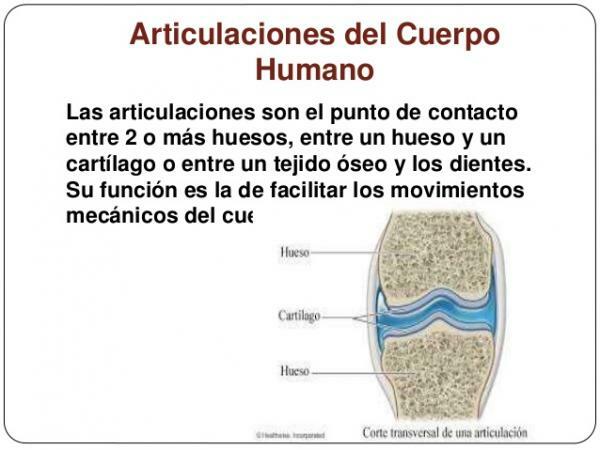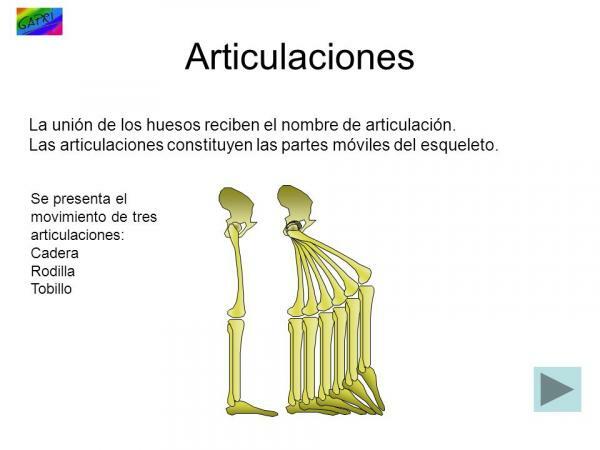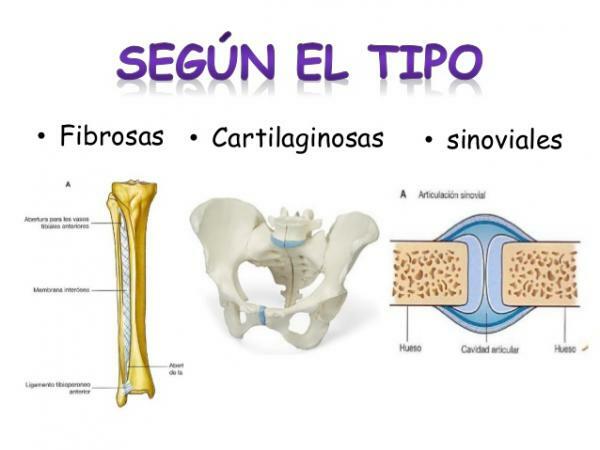Joints of the human body: names, types and movements

Image: SlideShare
One of the main properties of humans is that we are vertebrates, that is, we have bones. These bones need to be attached to each other or to other structures to form the skeletal system. These unions are called joints and in our body we can find them under different names, depending on the type and movement they allow. In this lesson from a TEACHER we are going to know the Human body joints: the names, types and movements, accompanied by images and easily and simply.
Index
- What are the joints of the human body for?
- Joint names and types
- Types of joint movements
What are the joints of the human body for?
The joint is the structure that allows junction between two bones or between a bone and cartilage (an elastic fabric that prevents bones from rubbing against each other and being damaged). To reform the union of the joints, ligaments appear, which join the ends of the bones and are mobile thanks to the muscles that are inserted close to them.
The function most important of the joints is unite the elements of the bone system (bone, cartilage) and facilitate mechanical movements, giving elasticity and flexibility to the body. Imagine that our entire skeletal system was made in one piece, like a wooden doll, and we had no joints, we couldn't move! Another important function of the joints is to allow the growth of bones during childhood and that, if the bones were united (welded) to each other from birth, we could not become more high!
Just like all the bones in our body are not the same, the joints are not the same either. In the human body we can distinguish 360 different joints They are given different names according to the type of movement they have or according to the fabric of which they are composed. In addition, in the case of having movement, they can be classified according to the direction that it follows. You want to know more? Next, we will look at the different names, types and movements of the joints.

Image: SlidePlayer
Names and types of joints.
We begin this lesson by discovering the names and types of the joints so that you can easily locate and know them. They are as follows:
Synarthrosis or fibrous joints
First, the joints can be immobile (to have no movement). These joints are scientifically called synarthrosis. In certain cases, it is convenient for us that the union of two bones does not move, so the joint does not leave free space between the two bones or the bone and the cartilage. These joints can also be called fibrous joints since that space is occupied by collagen fibers.
Examples of non-moving joints or synarthrosis are: the skull sutures (joints between the different bones of the skull) or the joints between the teeth and the jaw. Imagine what could happen to your brain if the bones in your skull could move!
Amphiarthrosis or cartilaginous joints
Second, we can find joints with little movement, that is, limited movements. You can also say that they are semi-mobile and they can be called amphiarthrosis. The joint in this case is made up of cartilaginous tissue, which gives the joint a little more flexibility without allowing it to have full motion. They are also called cartilaginous joints.
Examples of these joints are the joint between the femur (thigh bone) and the hip or the joints between the vertebrae, which allow us to bend over ourselves.
Diarthrosis or synovial joints
Finally, some joints have full motion, that is, wide movements. They are scientifically called diarthrosis. These joints suffer a lot of wear and tear due to movement, so they have a fluid-filled space (synovial fluid) between the cartilage at the ends of the bones that they articulate. For this reason they are also called synovial joints.
Some examples of joints with this type of movement are the elbow, shoulder or ankle and they allow us to have a lot of mobility in the extremities.

Image: SlideShare
Types of joint movements.
Joints that have motion, either semi-mobile (amphiarthrosis) or full motion (diarthrosis) can describe different planes of motion. Some examples, although there are more, are:
- Hinge joints: In this case, the joint can only perform extension and flexion movements, that is, only in one plane. For example, the elbows and knees are perform hinge movements.
- Pivot joints: In this case the joint allows only the rotation of one bone on another. One bone fits over another in a similar way to how a finger fits a ring. An example is the shoulder or hip joint.
- Flat or sliding joints: Joints of this type are flat so they only allow sliding movements between the two bones. An example is the intercarpal joint, which joins the bones that make up the palm of the hand, but also the ankle or wrist joints.
- Ball joints: In spherical joints, one of the bones is ball-shaped and the other a receptacle. This allows free movement to occur in any direction. Examples of spherical joints are the coxofemoral (it relates the hip to the femur) and the humerus-scapular (it relates the shoulder to the humerus).
- Condyloid joints: Condyloid or condyle-type joints are formed by the union of two irregular bones, one concave (with an inward cleft) and the other convex (with an outward cleft). These joints can be more or less round, as in the case of the patella.
If you want to read more articles similar to Joints of the human body: names, types and movements, we recommend that you enter our category of biology.



